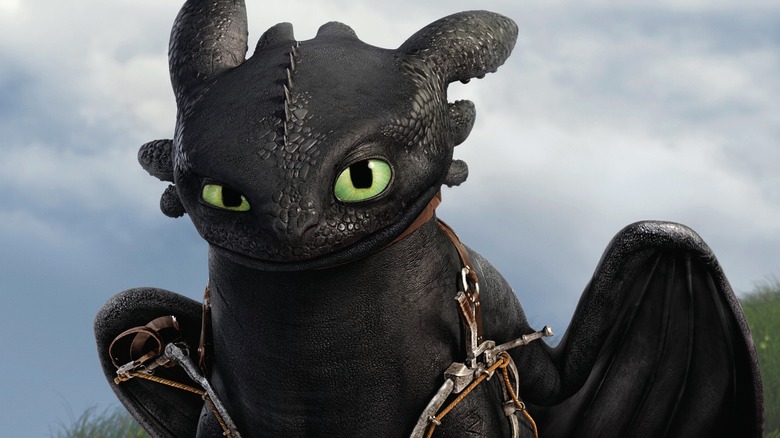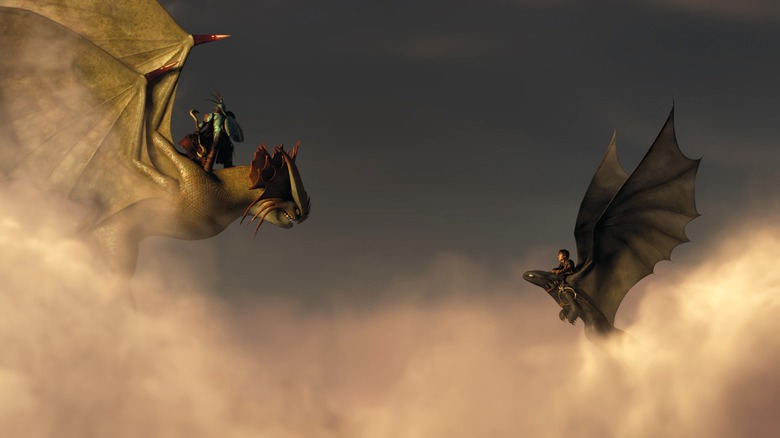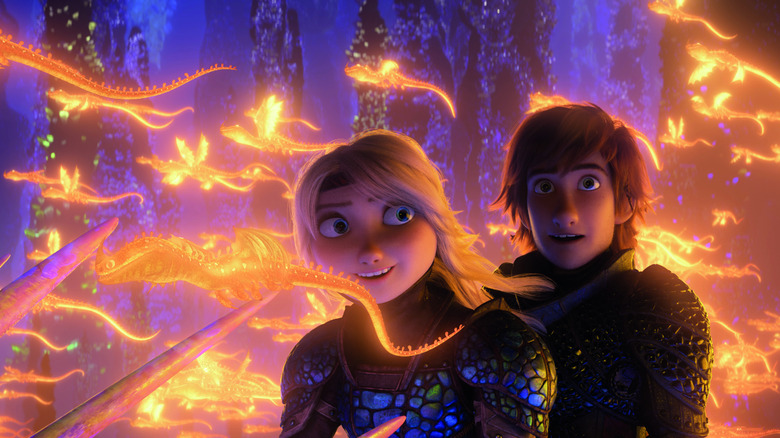The How To Train Your Dragon Franchise's Rotten Tomatoes Scores Are Mind-Boggling
"Shrek" may still be the series for which DreamWorks Animation is best known, but the "How to Train Your Dragon" trilogy is arguably the studio's greatest achievement. The fantasy films have an astounding consistency of quality, both according to critics and regular moviegoers. On review aggregator Rotten Tomatoes, the first film has a near-perfect 99% positive score from professional reviewers and a similarly impressive 91% audience rating.
"How to Train Your Dragon 2" dropped a bit in ratings, but it still holds a strong 92% positive score from critics and 90% from fans. Even the trilogy's final entry — the poorest-reviewed of the bunch, "How to Train Your Dragon: The Hidden World" — boasts a 90% critical score and an 87% audience rating.
So what's the secret? How, in a world where family-friendly animated adventures are often maligned for generic storytelling and cheap laughs, has the "How to Train Your Dragon" franchise found so much sustained success? Maybe it's John Powell's soaring orchestral score or the bright colors that paint the films' fantastical world. Maybe it's the voice cast, which eschews the modern animated template by avoiding massive celebrity rosters. Or maybe it's something more holistic — an overall sincerity that elevates "How to Train Your Dragon" above its genre.
How to Train Your Dragon embraces the style of an epic
Excluding Pixar (at least until recently), American animated family films generally followed a similar path. A simple premise that makes use of the visual medium, a healthy smattering of fart jokes and all-around juvenile humor, and a celebrity cast list so long it can fill its own poster, absent many actual, career voice actors — that's the formula. Toss in a basic plot structure with a few heartstring-tugging moments, and you're golden. From Illumination's standard fare to even other DreamWorks properties like "Megamind," that was the way of things through the 2000s and 2010s. It brought box office results, but not necessarily critical acclaim.
What sets "How to Train Your Dragon" apart is its willingness to embrace a more fantastical and sincere tone without sacrificing the fun. Reviewing the first film, Tom Horgen of the Minneapolis Star Tribune called it "an exhilarating epic that mixes comedic and touching moments with some of the best action sequences ever created with CGI animation."
The animation and choreography of the films' set-piece battles are certainly a big part of their unique success. "Its thundering air-war sequences, with hordes of dragon-riding fighters swarming into battle, have the swooping, gliding kineticism of vintage newsreels of World War II dogfights," New York Times reviewer Stephen Holden wrote in his review of "How to Train Your Dragon 2." But it's not just the visuals that elevate the story. It's the way each entry presents new challenges to its ever-growing characters.
How to Train Your Dragon is a proper trilogy
Making a hit animated film isn't easy, but it's been done. Heck, Pixar's done it a dozen times. What makes "How to Train Your Dragon" so impressive is that all three movies have received similar levels of acclaim.
The first film provides a great foundation, taking huge cues from Cressida Cowell's children's books and establishing the series' heightened audiovisual style. But too often, animated sequels simply retread the same territory. "Frozen II" is a great example of this — a movie that was so desperately to capture the zeitgeist of its predecessor that it wound up being a poor copy instead. Even the "Shrek" franchise fizzled by its third entry, with the writers seemingly out of interesting places for the characters to go.
"How to Train Your Dragon" embraces change. It welcomes the in-universe passage of time, the ongoing development of characters, and the emotional expansion into more complex ideas. Hiccup, Toothless, Astrid, and the rest of the crew have full arcs over the course of the trilogy, with each installment revealing new aspects of their character. This cohesion and persistent progression — combined with a never-ceasing dedication to visual excellence — is what makes the franchise so satisfying.
It remains to be seen if the upcoming live-action "How to Train Your Dragon" reboot can capture that same magic. Without the stunning visuals of the original trilogy's animation, it may be a tall task.


